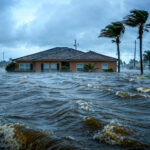Here’s another reminder of how cold it’s been so far this season.
Yesterday snow cover across the contiguous 48 states reached 50.4 percent before dropping back to 50.2 today, according to model estimates from the National Operational Hydrologic Remote Sensing Center in Chanhassen, Minnesota.
It’s the earliest that the halfway mark has been passed since the current method for measuring began 2008, an event that usually doesn’t happen until December, said Anders Nilsson, a software engineer at the center. It even beats the record going back to 2003 when a different methodology was used that included parts of Canada.
It seems like snow is everywhere right now. Two days ago, Amarillo, Texas received 2.5 inches (6.4 centimeters), according to the National Weather Service. Dodge City, Kansas got 2.1 inches and 1.6 inches fell in Paducah, Kentucky, a daily record in both cities.
Across parts of Oklahoma got between a half-inch to five inches.
For meteorologists, the takeaway of the snow story is easy to figure out. Non-meteorologists could have guessed it too.
“It means we’re in a cold weather pattern,” said Tom Kines, a meteorologist at AccuWeather Inc. in State College, Pennsylvania.
November has been cold, will become colder and may even get a little snowier. Kines said when he looks at snow falling in the Ohio River Valley, which stretches from Illinois to Pennsylvania, and then looks at the calendar, it gives him pause.
“It is certainly unusual for this time of the season,” Kines said. “Whenever you get snow before Nov. 20 in the Ohio Valley area that is very unusual.”
Better Way
While snow-covered landscapes offer a great visual for how cold it is, the market has a better way to measure the chill and its economic impact.
Natural gas-weighted heating degree days are calculated by subtracting the daily average temperature from a base of 65 degrees Fahrenheit and giving more weight to those areas that burn natural gas for heating. The number can tell you with a glance both how cold it has been and in rough terms whether more fuel was burned or not to heat homes and businesses.
Commodity Weather Group LLC estimates November’s gas- weighted heating degree value will be 673.5, up from 605 last year.
By gas-weighted heating degree days, November 2014 is on track to be the coldest since 1996, said Matt Rogers, president of Commodity Weather in Bethesda, Maryland.
Winter Predictor
While Rogers said he doesn’t believe November can be used as a predictor for the entire winter, Michael Schlacter at Weather 2000 Inc. in New York said it can.
The reason November is so cold is the result of larger forces that will result in the winter rivaling last year, Schlacter said. A forecast El Nino, which could bring a mild winter to the northern U.S., either won’t show up or will be weak, he said.
In addition, the Arctic and North Atlantic oscillations may shift to their negative phases, letting cold air spill out of the polar region and get bottled up in the eastern U.S., he said. On top of that is drought, which can enhance colder conditions.
“People put last year on such a pedestal like we’ll never see that again,” Schlacter said. It can happen again, he said.
Then there is the snow itself.
Snow Cover
“From a local perspective, having snow cover on the ground results in sharply lower temperatures at a given location that you would have otherwise, which results in much higher heating demand,” said Todd Crawford, a meteorologist at Weather Services International in Andover, Massachusetts.
Snow cover reflects a lot of sunlight back into space, Crawford said. “So instead of the solar radiation being used to heat the ground and lower atmosphere, the energy is basically wasted, resulting in a cooler atmosphere from a global perspective.”
Kines said he sees more cold ahead in the forecast.
“The first batch of cold air that came in last week, while it was cold, it kind of oozed in,” Kines said. “This one is blasting in and it is going to be accompanied by some very high wind.”
As for snow, the large cities of the East Coast won’t see any, he said. The regions around the Great Lakes are a different story.
“They will be measuring that snow in feet, not inches,” said Kines.





















 Safeco to Stop Writing New Condo and Renter Policies in California
Safeco to Stop Writing New Condo and Renter Policies in California  Embroker CEO Reflects on Tech, Insurance Journey
Embroker CEO Reflects on Tech, Insurance Journey  Dear Elon and Vivek: Insurance Commissioners Urge DOGE to Ditch FIO
Dear Elon and Vivek: Insurance Commissioners Urge DOGE to Ditch FIO  Moody’s: Rising Flood Risks Posing Greater Challenges for Eastern and Southern U.S.
Moody’s: Rising Flood Risks Posing Greater Challenges for Eastern and Southern U.S. 






